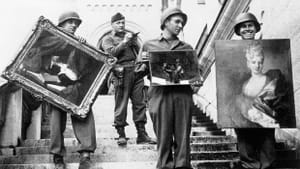Stay in the Loop
BSR publishes on a weekly schedule, with an email newsletter every Wednesday and Thursday morning. There’s no paywall, and subscribing is always free.
Is art worth dying for?
'Ainadamar' and 'The Monuments Men'

How important is art to modern civilization? Is it worth dying for?
When so many local productions have been focused on dysfunctional family relationships (think August, Osage County; Tribes at Philadelphia Theatre Company; Cherokee at the Wilma Theater; Stick Fly at the Arden Theatre Company; and even Emma, by Jane Austen, that mistress of nuanced relationships, at the Lantern Theater Company), it’s nice when creative artists tackle the larger subjects of our time, like life and death and art and the meaning of it all.
In Ainadamar and The Monuments Men, two very different creators tackle two very different stories, which nevertheless, at their heart, ask essentially the same question: Is art worth dying for? And its corollary: Does society depend on the arts and its artists? This is similar to the question we often hear discussed in another context — whether our lives and well-being depend on saving endangered species like the polar bear. And yes, I am likening art in its classical forms to an endangered species, since we seem determined to remove it from our children’s education and their lives, and it is often out of the reach of even adults who would like to participate more.
Ainadamar, almost a dream poem on the life and death by firing squad of Spanish poet and political activist Federico García Lorca, confronts us with the quandary of whether the artist should focus solely on his art or fight for what he believes in the real world. While Lorca himself chose to take a stand, his muse, Margarita Xirgu, played forcefully by María Hinojosa Montenegro, left Spain for Havana and never returned, because she saw her role as keeping him alive by keeping his art alive even after his death, even to the moment of her own death. “When our voices are silent, we disappear,” she says.
The opera itself challenges expectations. Composer, choreographer, dance troupe, computer graphic artist, and, as the gentleman who gave a short presentation before the opera said, a talented “laptop-ist,” conspire to create a unique, dynamic art form that can be enjoyed no matter what your opinion on the subject.
Singers are amplified so they are not drowned out by the movement and sound around them. Images are projected on a screen that occupies center stage as building, screen, setting. Stones weep, clouds fill the sky, stars explode, historical images appear and disappear, dancers move through a train station or create tableaux of war. Meanwhile, the recurring sound of the pounding feet of the flamenco threatens Lorca and his friends. It’s sensory overload but in a good way.
Missing the mark
The Monuments Men, on the other hand, is a flawed attempt to tell the story of the men (and a woman) who were sent to identify and preserve the artworks the Nazis were determined either to possess or, if they could not possess them, to destroy. In one sense, the Nazis' desire for art validates the premise — art matters, either because it is a treasured possession or because it is threatening.
The story, however, fails. It’s as if George Clooney said to his friends, “Let’s get together and make a movie,” and then cobbled together a series of anecdotes about the actual monuments men. A much clearer depiction can be found in the documentary The Rape of Europa — if you’re planning to see The Monuments Men, you should see that first so you can sit back and enjoy watching Clooney et al do their thing. They are fun to watch, even if the tension is contrived and the story lacking.
Throughout the film, in a rather heavy-handed manner, Clooney asks whether saving the great artworks of Europe was worth the death of the two men who died in this particular version of the story. His final statements in the film reflect an assumption that without art and artists, civilizations would crumble and life would not be worth living.
There are some other questions that might be pondered along with these. For one, even though the great works of art were saved, how many of us have actually seen them? Great art lives in private collections and large museums, both limiting the number of people who can gaze at them regularly. The same might be asked of Lorca’s work. How many of us in this country have an experience of his poetry? How many can read him in the original? While technology may have put representations of art at our fingertips, that is not the same as experiencing the real thing.
That does not mean we should not preserve these works. And just as with the dilemma of zoos, if we do not preserve these works somewhere, then they may not exist at all — and that diminishes all of us.
The two works that pose these questions are quite different, but ultimately, whether through a successful opera or a less than successful film, I think it’s important that artists of all sorts tackle the big questions as well as the nuances of everyday life.
For Steve Cohen's review of Ainadamar, click here.
For Armen Pandola's story on The Monument Men, focusing on the story's Philadelphia connection, click here.
For Robert Zaller's review of The Monument Men, click here.
What, When, Where
Ainadamar “Fountain of Tears”: An Opera in Three Images, Music by Osvaldo Golijov, Text by David Henry Hwang. Luis de Tavira, director; Corrado Rovaris, conductor. Compañía Antonio Gades dancers. Through February 16. Opera Philadelphia at Academy of Music, 240 S. Broad St., Philadelphia. 215-893-1018 or operaphila.org.
The Monuments Men, by George Clooney and Grant Heslov (screenplay), Robert M. Edsel and Bret Witter (book). George Clooney directed. For Philadelphia area showtimes, click here.
Sign up for our newsletter
All of the week's new articles, all in one place. Sign up for the free weekly BSR newsletters, and don't miss a conversation.

 Naomi Orwin
Naomi Orwin